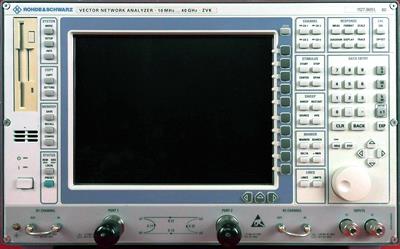Custom-Cal has a high success rate in the repair of the ROHDE & SCHWARZ ZVK. A calibration by Custom-Cal is performed by engineers with extensive OEM experience. We have the expertise and the necessary standards to perform the ROHDE & SCHWARZ ZVK Calibration, onsite calibration may be available.
We specialize in quick turnaround times and we can handle expedited deliveries upon request.
Need another Network Analyzer, SNA, VNA?
Shop for Comparable Products on our
used Network Analyzer, SNA, VNA page
or
new Network Analyzer, SNA, VNA page
More
|

|
|
The R&S ZVK (1127.8651.60) 40 GHz Network Analyzer is a compact instrument with an integrated generator, two reference and two receiver channels and a bidirectional test set. This can be extended by attenuators with integrated switches in the generator and receiver paths. With this configuration, the ZVK offers direct access to all reference and receiver channels. This concept makes the ZVK well equipped for complex test setups, for example for bidirectional measurements on power amplifiers. The ZVK has two independent synthesizers for the generator and the receiver. In the receiver sections, fundamental mixing is used up to high frequencies to provide the excellent dynamic range and outstanding selectivity, enabling straightforward measurements on frequency-converting DUTs or DUTs with extremely high selectivity. By transforming measurement data from the frequency to the time domain, discontinuities or impedances along the DUT can be displayed as a function of DUT length. With a maximum number of 2001 points, ZVM and ZVK can measure even very long DUTs with high resolution. Five filters allow the location of a discontinuity and the sidelobe suppression to be determined with optimum resolution. The S-parameters of a given discontinuity can be displayed in the time domain by setting a window (gating). An additional processor module included in the corresponding option accelerates data processing and the display of results to provide even realtime display – a valuable aid, for example in the tuning of bandpass filters with time domain transformation. Specifications. Frequency range: 10 MHz to 40 GHz. Frequency resolution: 100 µHz. Impedance: 50 ohm. Test ports: 2.92 mm male. Measurement time (normalized): <0.7 ms/point. Output power: 0 dBm/-5 dBm to -85 dBm. Power uncertainty: <1 dB to 2 dB. Dynamic range(IF bandwidth 10 Hz): >80 dB (<0.5 GHz), >110 dB (0.5 GHz to 8 GHz), >105 dB (8 GHz to 16 GHz), >90 dB (16 GHz to 20 GHz), >90 dB (20 GHz to 28 GHz), >80 dB (28 GHz to 40 GHz). Measurement bandwidths: 1 Hz to 10 kHz (in 9 steps) and 26 kHz. Options. B1 - AutoKal. B2 - Time Domain. B4 - Mixer Measurements. B5 - Nonlinear Measurements. B7 - Power Calibration. B8 - 3-Port Adapter. K9 - Virtual Embedding Networks. B14 - 4-Port Adapter. B16 - Ethernet Interface for internal PC. B17 - IEC/IEEE-Bus Interface for internal PC. B21 - Generator Step Attenuator PORT 1. B22 - Generator Step Attenuator PORT 2. B23 - Receiver Step Attenuator PORT 1. B24 - Receiver Step Attenuator PORT 2.
|